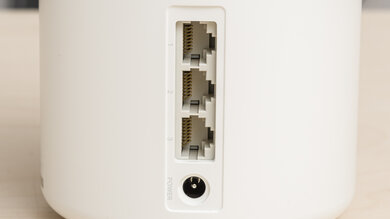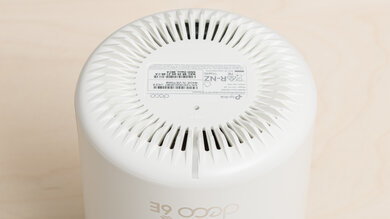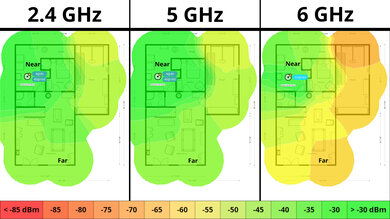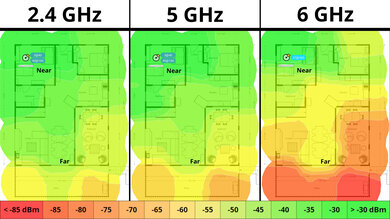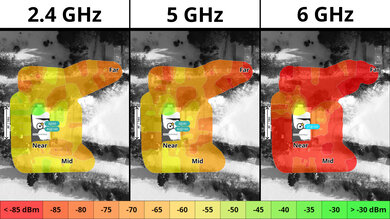The TP-Link Deco XE5300 is a tri-band Wi-Fi 6E router with 2.4GHz, 5GHz, and 6GHz bands. It's designed for use in a mesh system and is sold in a three-pack. Like TP-Link's other Deco routers, it has a simple design with a small footprint, and you set it up and manage it through the Deco app. It's compatible with Amazon Alexa-enabled devices for voice control.
Our Verdict
The TP-Link Deco AXE5300 is a great router if you live in an apartment, condo, or single-story home. It has a simple design and a small body that easily fits into your living space. It provides impressive network coverage and speeds fast enough for high-bandwidth activities like streaming 4k video and even game streaming. While it has three networking ports, they're only rated for 1Gbps, so you can't use multi-gigabit speeds.
-
Small and sleek design.
-
Wi-Fi 6E support.
-
Great top speeds.
-
Lacks multi-gigabit networking ports.
The TP-Link Deco AXE5300 is a very good router if you live in a multi-level home with a backyard. It provides great coverage throughout your home with fast enough speeds for high-bitrate 4k video streaming. It's also compatible with every other TP-Link Deco model, so you can easily add more access points for better coverage throughout your home or in your backyard. It has three networking ports, but they're only rated for 1Gbps, so you can't take advantage of devices capable of multi-gigabit speeds.
-
Small and sleek design.
-
Impressive range performance.
-
Wi-Fi 6E support.
-
Can add additional mesh access points to improve range.
-
Great top speeds.
-
Lacks multi-gigabit networking ports.
-
6GHz band is slower than the 5GHz band when connected to the satellite unit.
The TP-Link Deco AXE5300 delivers impressive speeds suitable for an internet connection of up to 1Gbps. It also supports DFS (Dynamic Frequency Selection), so it can take advantage of less congested DFS-only channels, which is especially useful if you live in a noisy wireless environment.
-
Great top speeds.
The TP-Link AXE5300 has great range performance. Since it's a mesh router, satellite access points help it maintain impressive average speeds over long distances, making it suitable for high-bandwidth uses and high-speed downloads over a wide area.
-
Impressive range performance.
-
Can add additional mesh access points to improve range.
-
6GHz band is slower than the 5GHz band when connected to the satellite unit.
Changelog
- Updated May 01, 2025: We've converted this review to Test Bench 0.8.1. This includes a new test result for our Test Configuration box.
-
Updated Jan 21, 2025:
Mentioned the TP-Link Archer AXE75 as a standalone Wi-Fi 6E router alternative in the Wi-Fi Specifications section.
- Updated Jul 22, 2024: Review published.
Check Price
Differences Between Sizes And Variants
The TP-Link Deco AXE5300 is only available in a three-pack, which we bought and tested in dual mesh and standalone modes. Here's a photo of our unit's label.
TP-Link also sells the nearly identical Deco XE75 and XE75 Pro, which are available in one, two, or three-packs. The XE75 Pro has a 2.5Gbps networking port and two gigabit ports.
Compared To Other Routers
The TP-Link Deco AXE5300 is a tri-band Wi-Fi 6E router with 2.4GHz, 5GHz, and 6GHz bands. It's designed for use in a mesh system and is sold in a three-pack. It's compatible with every other TP-Link Deco model so that you can add more access points for better coverage. Other integrated mesh routers, like eero, have this functionality as well.
Overall, it performs pretty similarly to other Wi-Fi 6E mesh routers. That said, it doesn't reach quite the same top speeds as the eero Pro 6E, but it's faster than the Google Nest Wifi Pro and has a better range than both competitors.
For more recommendations, check out the best mesh Wi-Fi systems, the best Wi-Fi routers for large homes, or the best routers for streaming.
The TP-Link Archer AXE75 and TP-Link Deco XE5300 are tri-band Wi-Fi 6E routers with DFS support. The main difference is their usage for mesh networks. Whereas the XE5300 comes as a three-pack for use in a mesh network, the AXE75 is sold as a standalone router but is configurable with other OneMesh-compatible devices for use in a mesh network. As a result, the XE5300 delivers more consistent and higher speeds over a longer range, making it ideal for larger multi-floor homes. By contrast, for people who live in a small apartment or condo, the AXE75's standalone configuration delivers comparable short-range performance to the XE5300.
The ASUS ZenWiFi ET9 and the TP-Link Deco XE5300 are Wi-Fi 6E mesh routers. They deliver similar performance, but the ASUS has better connectivity with more LAN ports, a USB port, and a faster WAN port that's capable of 2.5Gbps.
Test Results
We tested this router in dual mesh mode. While there's a slight speed penalty when connected to the satellite, this is expected, and the additional access point helps deliver more consistent speeds over very long distances.
Note that this test's average 6GHz speed was slightly slower than the average 5GHz speed while connected to the satellite unit. While we don't know precisely why this occurs, our best guess is that the mesh system uses the 5GHz band for wireless backhaul between the main router and the satellite unit when it detects usage on the 6GHz band, bottlenecking the speeds. That said, this is just a theory. We encourage you to reach out in the comments section if you have any feedback on this or any theories of your own.
We tested this router in dual mesh mode. There's a slight speed penalty when connected to the satellite, but this is expected, and the router still delivers impressive speeds up to 60 feet.
Wi-Fi 6E gives access to the 6GHz band, which takes advantage of less signal interference for faster speeds, but you'll need devices that support it to benefit from it. If you just need a standalone router and are looking for a Wi-Fi 6E option, consider the TP-Link Archer AXE75.
Comments
TP-Link Deco XE5300: Main Discussion
Let us know why you want us to review the product here, or encourage others to vote for this product.
Update: We’ve converted this review to Test Bench 0.8.1. This includes a new test result for our Test Configuration box.



